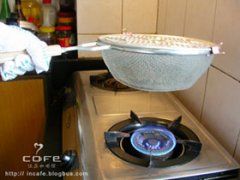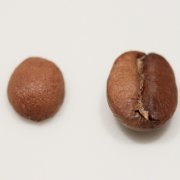About baking
The average chemical composition of raw coffee beans is as follows:
Water 12%, nitrogen 12%, fat 12%, sugar and dextrin (dextrine) 10%, other non-nitrogen substances 18%, dust 4%, tannin 6.7%, caffeine 1.2%, coffee essential oil 0.1%.
Of course, these figures are not fixed, and the number of some ingredients varies greatly, which is why each type of coffee is so different. The baking process involves heating the beans to 200-220 degrees Celsius in a special large container and stirring the beans continuously for up to 20 minutes.
This process ends when the beans are dark brown. In many countries, baking ends when the beans are light brown, but the timing of all these stops is determined by taste.
During baking, beans lose about 18-22% of their weight, which is actually due to a number of factors: water is evaporated, sugar is caramelized, tannins and fat are reduced. An important indicator of baking (aspect) is that beans should be baked the same on the inside as on the outside. In the baking process, the volume of beans can increase by up to 60%, so the proportion is greatly reduced. The coffee essential oil in the beans runs to the surface, showing aromatic properties (developing an aromatic element). Coffee (coffeone) contains more than 600 chemicals, giving the coffee a charming flavor. In any case, baking must not be "push" too much to improve the aroma, as this may cause many components in the coffee to volatilize, thus risking reducing the aroma.
Cooling: as soon as the beans leave the roaster, they must be cooled immediately so as not to cause the beans to roast deeper than they have reached due to the self-baking effect. There are three ways to cool beans:
1) Water cooling: spray water on hot beans that have just been baked to cool them. Because coffee absorbs water easily, this process significantly increases the proportion of beans.
2) cooling with ordinary air
3) cooling with cooled air

Important Notice :
前街咖啡 FrontStreet Coffee has moved to new addredd:
FrontStreet Coffee Address: 315,Donghua East Road,GuangZhou
Tel:020 38364473
- Prev

Some common household baking appliances
The simplest, of course, is the mobile network ~ ~ Price: 10-100. Recommended: * (picture from incafe.blogbus.com) retrofit street popcorn pot price: 10-300 recommended: * * (the picture comes from hohojazz.blogcn.com) oven price: 99-599 recommended: * stuffed pot baking, represented by Beibei No. 1 price: 200600, depending on the material recommended: * * Note: this picture
- Next

Discuss several flaws to avoid when baking
There are several defects to avoid when baking. Unripe beans. Beans are small and difficult to color. Coke beans. The reason is that the temperature is too high when entering the beans, and the beans are burnt. Bean tail coke. After the beans into the drum temperature is too high, or too slow rotation. Center focus. Dehydration to a burst of excessive fire. Impact crater. The first explosion to the second explosion stage, the fire is too strong. Not fully baked beans. A burst just finished, but can be used for cup testing. Attention beans
Related
- Beginners will see the "Coffee pull flower" guide!
- What is the difference between ice blog purified milk and ordinary milk coffee?
- Why is the Philippines the largest producer of crops in Liberia?
- For coffee extraction, should the fine powder be retained?
- How does extracted espresso fill pressed powder? How much strength does it take to press the powder?
- How to make jasmine cold extract coffee? Is the jasmine + latte good?
- Will this little toy really make the coffee taste better? How does Lily Drip affect coffee extraction?
- Will the action of slapping the filter cup also affect coffee extraction?
- What's the difference between powder-to-water ratio and powder-to-liquid ratio?
- What is the Ethiopian local species? What does it have to do with Heirloom native species?

